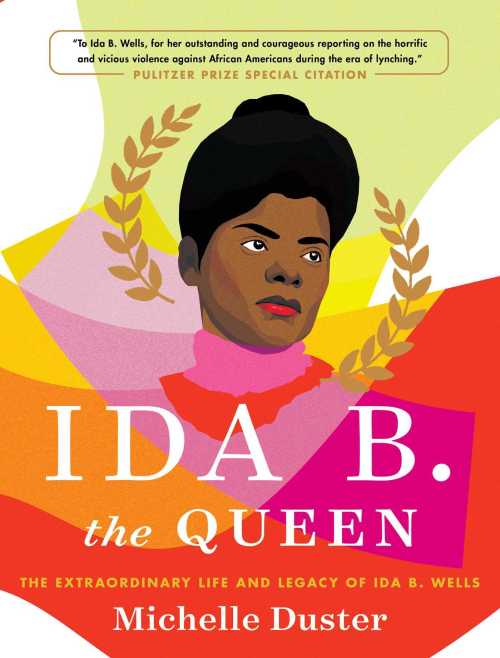[ad_1]
Reading about Ida B. Wells is like reading a biography of activism itself, of a whole flock of lives lived. Born into enslavement in Mississippi in 1862, Wells died in 1931, a year after running for the Illinois State Senate. In between, she became, at sixteen, the primary caregiver to five younger siblings after her parents died in the Yellow Fever epidemic; a teacher; a litigant fighting Jim Crow railroad laws; a journalist and owner of a newspaper; a fired teacher for reporting on disparities between white and Black schools; a journalist whose press was destroyed after she reported on lynching; a citizen who met directly with William McKinley about lynching legislation and Woodrow Wilson about segregation; founder of the Negro Fellowship League neighborhood center, the rent for which she paid from her job as Chicago’s first female probation officer; a mother of four; a founder of and activist within multiple organizations for gender equality and racial justice, including the Alpha Suffrage Club and the NAACP; the integrator of the 1913 Washington, D.C., suffrage parade; the subject of an FBI investigation; and, always, a writer shining light on the facts.
In a new biography aimed at teens, Ida B. the Queen: The Extraordinary Life and Legacy of Ida B. Wells, her great-granddaughter, Michelle Duster, combines the major nodes of this exceptional life with a 400-year timeline contextualizing her great-grandmother’s work. This engaging story illuminates history through the efforts of one of its most remarkable activists – a woman who exhibits at every step excellence and, in its wake, endures dangerous backlash. The story feels, too, like a mirror reflecting back a distorted image of the issues of our own time. Readers newer to Wells’s legacy will find an accessible introduction to her life, what it meant in her time, and how it connects to ours. But even readers with prior knowledge of Ida B. Wells will find new details about her life as well as excerpts from her diary, historical documents, and family photos. Duster – an author, speaker, professor, and activist in her own right – also writes more personally about what her great-grandmother’s legacy has meant for her family and for her own life.
I spoke with Michelle Duster by phone about how her new book reflects her own Ida B. Wells education, what she still wonders about her family history, and what she wants her book to say to young women looking to change the world.

Rebecca Entel
You’ve been writing about Ida B. Wells for years and working on preserving and honoring her life. What led you to this new project and what are the most important things Ida B. The Queen adds to your body of work?
Michelle Duster
What led me to this project is just the reality that there was a little bit of a gap when it comes to the work that’s been written about her. There are several children’s books, younger children’s books, and then there are several books that are more college level. In the market space in between, there weren’t a lot of books written. So it just made sense at this point to help a younger generation to learn about her at a younger age. It seemed to be the right time because it was the centennial of the Nineteenth Amendment in 2020, so there was a lot of focus on the suffrage movement and a lot of effort to help people know the contributions that Black women made. Overall it seemed like it was a good time to create something that would help younger women to learn the history that helped us be where we are today.
Rebecca Entel
You dedicate the book to those who speak out against injustice, and in your acknowledgments you specifically mention those younger women. What are some specific things that you’d like readers to learn from this book in terms of their own activism or potential activism?
Michelle Duster
When it comes to Ida’s life, one of the things she did was use the truth as a way to combat false narratives. If you really notice the tactics that she used, especially when it came to her journalism, she didn’t really argue with people about where they stand on different issues. She just literally presented the facts and let the facts speak for themselves. I think that’s a powerful message for people to take from that: you can literally just collect information and present it in a way that makes your point.
Rebecca Entel
You begin the book with a story of the FBI visiting your great-grandmother because she had created buttons honoring Black soldiers executed by the government during World War I. Why did you choose to start the story at that particular moment and why tell the story of her life non-chronologically?
Michelle Duster
I personally found that story to be very fascinating. I was just blown away by the fact that I have a family member who was investigated by the FBI! Just the fact that she was not intimidated by being questioned by them. I thought that encapsulated her personality and her approach to the work that she was doing. That, to me, just really showed who she was on every level: the fact that she was not intimidated by being questioned and investigated and the fact that she stood her ground when it came to her opinion about what the government did to its own military personnel. On multiple levels, I thought that was a really good way to show her. Also I found it interesting to illustrate how, if you decide to speak up about something, you have to be brave enough to suffer the potential consequences and be clear enough about why you’re doing something or why you believe in something strongly enough to be willing to potentially have something happen. On all those levels, I thought that was a really good story to draw people in to ask, who is this woman who is willing to stand up to the government?
As far as why the book is written in a non-chronological way, actually it’s sort of the way that I learned about her. I learned about my great-grandmother in pieces and sometimes that is the way people learn about their family members. They tell you in little snippets. So that emulated my experience learning about her.
Rebecca Entel
And then you have the timeline farther into the book where readers can place all the snippets together in a narrative.
Michelle Duster
I really wanted to have the timeline be over 400 years because I think it’s important for people to understand where Ida fits in with our country’s history. Obviously things happened before her, and things happened after her life. She lived sixty-eight years, so that’s a short amount of time when you consider a 400-year history. She was obviously influenced by the circumstances she was born in, but also she was working on a continuum of resistance that came before her. It’s a good thing for people to realize that we all fit into a continuum of where people have come from and where they’re going as a society.
It’s important for people to understand that what’s happening today didn’t come out of nowhere. There were people who came before us who paved the way for the rights that we enjoy today. And I’m hoping it will help people understand that my great-grandmother’s life, although she’s a historic figure, is relevant today. The past affects the present. When people understand that, it makes the past more dynamic.
Rebecca Entel
This book is an archive of your great-grandmother’s successes, but you also pay a lot of attention to her setbacks and the backlash she encountered. Why was it important to you to include those experiences alongside her accomplishments?
Michelle Duster
As somebody who grew up as a descendent of hers, I was very well aware of the sacrifices that she made and the danger that she faced. So that was part of the story that I grew up with: that her life was not easy. I think it’s important for people to be inspired by her life but, also, understand that she was human –she had setbacks like everybody has setbacks –and see how she continued moving forward despite those setbacks. It is a testimony to resilience without glossing over and making it seem like not a big deal that she did have some challenges. I think that humanizes her.
Rebecca Entel
As the subtitle of the book says, Ida B. Wells is so extraordinary and in many ways her life is one of a kind, and yet in the book you also illustrate how she was enmeshed in networks of other activists and movements. What do you want readers to gain from understanding those relationships?
Michelle Duster
It’s important for people to understand that there’s more than one way that people can fight for a cause, and my great-grandmother’s life illustrates almost every way that is possible. She fought alone, and sometimes frankly did express, privately in her diary, that she felt very alone, and that’s important for people to know, that sometimes you really do have to stand alone and believe in your convictions enough to be willing to do that. But sometimes it helps to work with other people because you can combine talents and resources and exchange ideas. And she used different tactics as far as writing, as well as speaking. She worked on behalf of racial injustice but also worked when it came to gender equality. That’s not unusual for people to have different organizations that have different goals and different foci as far as what they’re working towards. And in some ways, it is difficult to do all by yourself. Collective energy is helpful. Plus some of the issues were national, and when you’re working with an organization, you can approach things from a national standpoint.
Rebecca Entel
In the book you reflect on your own changing view of and understanding of your great-grandmother at different times in your life. Do you see her legacy differently as a result of writing this book? Is there anything new that you learned?
Michelle Duster
I was in the midst of writing and editing the book during the centennial of the Nineteenth Amendment, so there’s a blurring of the lines as far as what I learned specifically about the book versus what I learned about the role of Black women in the suffrage movement. That history has been very much under-told, and I was really happy to see that my great-grandmother got as much attention and credit in 2020 as she did. I learned how passionate people are about her and how much of an effort there is, on a national basis, for her and the other women who were involved in that movement to really get the attention and the credit in documenting this history. There are several historians and scholars who have published very recently several different books that are about Black women specifically involved in the suffrage movement: how it didn’t start in 1848 with Elizabeth Cady Stanton, there were different parallel movements, and things were different in different regions. For instance, my great-grandmother got the right to vote in 1913, [because of] limited suffrage in Illinois, but all women didn’t have that opportunity because people were getting the right state by state. So she was able to be involved in not only voting but also canvassing for candidates, and she was influential when it came to certain elections. Women in other states didn’t have that opportunity. That was interesting for me to learn: more details about the dynamics of the suffrage movement.
Rebecca Entel
The Yellow Fever epidemic, in which she lost her parents, so clearly changed the course of Ida B. Wells’s life. As you were working on this book during a pandemic, was there a different lens through which you were looking at that event?
Michelle Duster
Not to minimize the 1878 Yellow Fever epidemic, because obviously that was a great loss for her; but, when I was working on this book, I was more trying to learn about the 1918 epidemic, because it was almost exactly a hundred years ago, and Ida was a mother of four children at that time. So I was wondering, how did they navigate that pandemic? That was a moment when I was working on the book that I really wished I could have talked to my grandmother – not my great-grandmother, but my grandmother – because she was fourteen during the 1918 pandemic. She was school age. I was wondering, how did they manage school? How did she deal with her friends? All of those types of things that a teenager would have to deal with. I was just curious about that. I looked at my great-grandmother’s autobiography, and she did not even mention the 1918 pandemic: wow, that’s interesting, and that made me even more curious. Why didn’t she feel the need to talk about that? That’s the thing about autobiographies that is interesting. The person who’s writing it is making choices about what they’re going to write about or not, a reflection of what’s important to them.
Rebecca Entel
Is there anything else you’d like to share about the book?
Michelle Duster
I’m hoping that people will be inspired by her life story and also curious to learn more about her. Obviously I didn’t cover everything, all the details of her entire life; the book is meant to be an introduction to her. I also edited two other books that include her original writings, Ida in Her Own Words and Ida from Abroad. The intention that I had was to help people hear her voice directly, which gives a window into the world that she’s living in, when you read her original writing. So my hope is that this book will spark enough curiosity and interest [for readers] to seek more information, get a bigger picture of who she was, and ultimately understand what our country is – why things are the way they are right now.
Rebecca Entel
Readers whose curiosity is piqued by Ida B. the Queen may be anxiously awaiting the safe reopening of museums so they can attend exhibits and see artifacts such as Ida’s desk at the DuSable Museum. In the meantime, thanks to your activism, they have several outdoor sites they can visit right now.
Michelle Duster
In Chicago, there’s the historical marker at 37th and King Drive, which I really am proud of, because I worked with Alderman [Sophia] King to have that created. I wanted to recognize that there was an entire community in that area, and I didn’t want that history to be forgotten. Her house is at 3624 South King Drive, so it’s just a half a block away. A monument will be installed at 37th and Langley, a few blocks east of King Drive. It will be completed this year, 2021 – I’m so happy about that! If people want to go to the cemetery, at Oak Woods Cemetery at 67th and Greenwood, her gravesite is there. People have gone there and put their I voted stickers on her headstone. Obviously Ida B. Wells Drive, if they want to go there and take in the aura.
In Memphis, there’s a marker on Beale Street. Beale Street Baptist Church is a landmark that’s connected to her, because that’s where her printing press originally was. If they keep driving south to Holly Springs, which is only a thirty-five-minute drive from Memphis, there’s the Ida B. Wells-Barnett Museum, and there’s also a marker that was recently placed in the town square. There’s also a marker for her parents, which is in the Hill Crest Cemetery. And there’s the Mississippi Writers Trail marker at Rust College.
There are some other things that are in the works that don’t exist yet. By this time next year, there will be some other things that people will be able to enjoy.

YOUNG ADULT
Ida B. the Queen: The Extraordinary Life and Legacy of Ida B. Wells
By Michelle Duster
One Signal Publishers
January 26, 2021
[ad_2]
Source link
